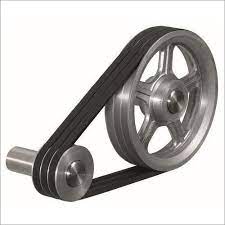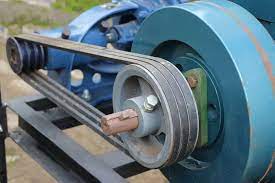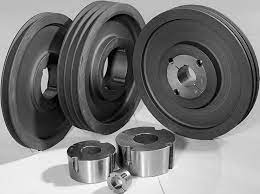Product Description
Rubber Conveyor Tail Drive Pulley for Conveyors in The Mining Industry
| Type | Belt width(mm) | Standard Diameter(mm) | Length(mm) |
| Drive pulley | 500 | 500 | Length of the pulley depends on the belt width of the conveyor |
| 650 | 500~630 | ||
| 800 | 630~1000 | ||
| 1000 | 800~1150 | ||
| 1200 | 800~1150 | ||
| 1400 | 1000~1350 | ||
| 1600 | 1150~1600 | ||
| 1800 | 1150~1800 | ||
| 2000 | 1350~2000 | ||
| 2200 | 1600~2200 | ||
| 2400 | 1800~2400 | ||
| Bend pulley | 500 | 250~500 | |
| 650 | 250~630 | ||
| 800 | 250~1000 | ||
| 1000 | 250~1600 | ||
| 1200 | 250~1600 | ||
| 1400 | 315~1600 | ||
| 1600 | 400~1600 | ||
| 1800 | 400~1600 | ||
| 2000 | 500~1600 | ||
| 2200 | 630~1600 | ||
| 2400 | 800~1600 |
1.)Pipe: seamless steel : it was precisely cut by using the flame cutting machine.
2.)The sleeve & disc :it was cut by using the laser cutter machine precisely.
3.)Shaft: We chose 45# round steel & sleeve and process the whole shaft so that it ensures shaft concentricity and reduction for the eccentric shaft force. It make sure the pulley move more stable
4.)Bearing set & bearing: high-quality bearing which is hot charging and bearing block are equipped inner bearing enlargement device, so the bearing can be easily pushed to the bearing position and it avoids the bearing damage from the beating.
Testing for the pulley
We have the professional testing machine for the pulley. We need make the eliminating inner stress treatments when the pulley’s withstand forces exceed 80KN and we will make the static balance inspection when the belt speed exceeds 2.5m/s.
And we laso make the Drum dynamic balance test for the pulley to confirm the good quality before sent to the customer.
Packing:
After all the goods tested then make the packing, then the goods put into the warehouse to wait to send to the customer
Our projects:
Exhitbition and the customer visiting~
We also attend many kinds of related exhibitations to know more our products for the customer. Such as Canton fair, buma fair andother minging fairs.
Our company and products get the customer approve and many customer vist us and make the orders for us.
Company certificate &honor
We have the ISO 9001 certification The products have gained various patents. For example: Trademarks, patents,ects.
After sale service
We provide the customer best after sale services, and we solve the problems any time.
The company introduction:
HangZhou CHINAMFG conveying Machinery Co.,Ltd was founded in 2005.
It’s registered capital is 11.68million CNY and It is private joint-stock enterprise. Our main products are cnoveyor roller,idler,frame, pulley,belt and belt conveyor system for TD75 ,DTII,DTIIA,CEMA ects.
we has large lathes, numerical control, double pressing machine, double welding machine, double boring lathe, milling machine, sawing machine and so on. The products have gained various patents. We can produce more than 1 thousand rollers and 10 pulleys per day.
We have the professionalQC dept. to keep the good quality before the goods sent out. The products are sold to Middle East,Africa ,Australia,Europe,Southeast Asia,Russia and some other countries and regions. We will Strengthen the inner management and improve our products’ quality constantly.We will offer the best products for customers from the beginning to the end.
FAQ
1.Q: Your bearing type and brand usually use?
A:Large ball bearing type deep ball bearing withSRB, and according to customer’s requirements.
2.Q: How is your Payment Term?
A: T/T or L/C. Another payment term we can also discuss.
3.Q: Can you customize it?
A: We support customization according to your request.
4.Q: What’s the MOQ?
A: 3 piece.
5.Q: What’s the production capacity of your conveyor pulley?
20 pcs/day.
6.Q: What’s your roller’s lifetime?
Our pulley have a long lifetime with good performance and usually
make sure 30000 to 50000 hours under the normal site and operation.
/* January 22, 2571 19:08:37 */!function(){function s(e,r){var a,o={};try{e&&e.split(“,”).forEach(function(e,t){e&&(a=e.match(/(.*?):(.*)$/))&&1
| Material: | Carbon Steel |
|---|---|
| Surface Treatment: | Electroplating |
| Motor Type: | Frequency Control Motor |
| Installation: | Horizontal |
| Bearing: | Self-Aligning Ball Bearings |
| Pulley Lagging Type: | Heat/Thermal Vulcanized Rubber Casting, Rubber Lag |
| Customization: |
Available
| Customized Request |
|---|

How do drive belt pulleys contribute to the functioning of agricultural equipment?
Drive belt pulleys play a crucial role in the functioning of agricultural equipment. Here’s a detailed explanation of how drive belt pulleys contribute to the operation of agricultural machinery:
1. Power Transmission:
Agricultural equipment, such as tractors, combines, and hay balers, often require the transfer of power from the engine to various components and attachments. Drive belt pulleys are used to transmit power from the engine’s crankshaft or power take-off (PTO) shaft to components like pumps, augers, conveyors, and cutting mechanisms. By connecting the engine to these components, the pulleys enable the transfer of rotational power, allowing the equipment to perform tasks such as harvesting, planting, and material handling.
2. Speed Control and Gear Reduction:
In agricultural machinery, it is essential to control the speed of various components or achieve gear reduction to match specific tasks and conditions. Drive belt pulleys, in combination with different pulley sizes or gear ratios, enable speed control and gear reduction. By adjusting the pulley sizes or using multiple pulleys, operators can modify the rotational speed of driven components, such as the cutting blades or conveyor belts, to optimize performance based on the requirements of the specific agricultural operation.
3. Belt-Driven Mechanisms:
Many agricultural machines utilize belt-driven mechanisms for functions like threshing, baling, or grain separation. Drive belt pulleys are integral components in these mechanisms, providing power transmission and tensioning for the belts. The pulleys ensure that the belts remain properly tensioned, enabling reliable power transfer and maintaining the desired operation of the belt-driven mechanisms in agricultural equipment.
4. Tensioning and Belt Adjustment:
Drive belt pulleys in agricultural equipment facilitate tensioning and adjustment of belts. Proper belt tension is critical for efficient power transmission and preventing slippage. Pulleys with adjustable positions or built-in tensioning mechanisms allow operators to easily adjust belt tension, ensuring optimal performance and preventing premature belt wear or damage. The ability to adjust belt tension is particularly important in agricultural equipment that may encounter variable loads or require periodic maintenance.
5. Implement Compatibility and Versatility:
Drive belt pulleys contribute to the compatibility and versatility of agricultural equipment. With the use of different pulley sizes or configurations, machinery manufacturers can design equipment that accommodates a wide range of implements and attachments. By selecting the appropriate pulley combination, operators can adapt the equipment to perform different tasks, such as switching between high-speed operations, like mowing, and low-speed operations, like tilling. This versatility enhances the efficiency and productivity of agricultural machinery.
6. Noise and Vibration Control:
Drive belt pulleys help control noise and vibrations in agricultural equipment. Well-designed pulleys with proper alignment and balanced operation minimize vibrations and reduce noise generated during equipment operation. This contributes to a quieter and more comfortable working environment for operators, especially during prolonged use of the machinery.
7. Maintenance and Serviceability:
Properly designed drive belt pulleys enhance the maintenance and serviceability of agricultural equipment. Pulleys that are easily accessible, with removable covers or guards, simplify maintenance procedures. This allows for efficient belt replacement, tension adjustment, or component servicing, reducing downtime and ensuring that the equipment remains operational during critical farming seasons.
8. Energy Efficiency:
Efficient power transmission is essential for achieving energy efficiency in agricultural machinery. Drive belt pulleys help optimize power transfer from the engine to the driven components, minimizing energy losses. Properly sized and designed pulleys ensure that power is efficiently delivered to perform agricultural tasks, resulting in reduced fuel consumption and lower operating costs for farmers.
In summary, drive belt pulleys are vital components in agricultural equipment, contributing to power transmission, speed control, belt-driven mechanisms, tensioning, implement compatibility, noise control, maintenance, serviceability, and energy efficiency. Their presence ensures the reliable and efficient operation of agricultural machinery, ultimately improving productivity and supporting the needs of modern farming practices.

What role do drive belt pulleys play in air conditioning and alternator systems?
Drive belt pulleys play a crucial role in both air conditioning and alternator systems in automotive applications. Here’s a detailed explanation of the role drive belt pulleys play in these systems:
Air Conditioning System:
In an automotive air conditioning system, the drive belt pulley is responsible for transmitting power from the engine’s crankshaft to the air conditioning compressor. The air conditioning compressor is a key component that pressurizes and circulates the refrigerant throughout the system, allowing for the cooling and dehumidification of the air inside the vehicle’s cabin.
The drive belt pulley is connected to the engine’s crankshaft, and as the engine rotates, it drives the pulley, which in turn spins the air conditioning compressor. This rotational motion of the compressor enables it to compress and circulate the refrigerant, absorbing heat from the cabin and releasing it outside, resulting in the cooling effect.
By driving the air conditioning compressor, the drive belt pulley ensures the proper functioning of the air conditioning system. It allows for the regulation of the compressor’s speed and power output, controlling the cooling capacity of the system based on the cabin temperature and the desired comfort level.
Alternator System:
In an automotive alternator system, the drive belt pulley is responsible for driving the alternator, which is a critical component for generating electrical power and charging the vehicle’s battery. The alternator converts mechanical energy from the engine’s rotation into electrical energy, supplying power to the electrical systems and recharging the battery while the engine is running.
The drive belt pulley is connected to the engine’s crankshaft, and as the engine rotates, it drives the pulley, which in turn spins the alternator. The rotational motion of the pulley drives the alternator’s internal rotor, which is surrounded by a stator and a set of windings. This relative motion between the rotor and stator induces an electrical current in the windings, generating the electrical power output.
The drive belt pulley ensures that the alternator operates at the correct speed and power output to meet the electrical demands of the vehicle. It provides the necessary mechanical power to drive the alternator and generate the required electrical energy, supplying power to the vehicle’s electrical systems, including the lights, ignition system, audio system, and various other electronic components.
Additionally, the drive belt pulley in the alternator system plays a role in the battery charging process. As the alternator generates electrical power, it also recharges the vehicle’s battery, ensuring that it remains charged and ready to supply electrical energy when the engine is not running or when the electrical load exceeds the alternator’s output capacity.
Overall, drive belt pulleys are essential components in both air conditioning and alternator systems in automotive applications. They facilitate the transfer of power from the engine’s crankshaft to the air conditioning compressor and alternator, enabling the proper functioning of these systems and ensuring the comfort and electrical reliability of the vehicle.

Can you explain the key components and design features of a drive belt pulley?
A drive belt pulley consists of several key components and design features that enable its efficient operation and power transmission. Here’s a detailed explanation of these components and features:
1. Pulley Wheel:
The pulley wheel is the main component of a drive belt pulley. It is typically a cylindrical or disk-shaped wheel with a grooved rim. The wheel is designed to accommodate the belt and provide a surface for power transmission. The grooves on the rim match the shape and size of the belt, ensuring a secure fit and optimal power transfer.
2. Grooves:
The grooves on the pulley wheel’s rim are an essential design feature. They provide the necessary contact points for the belt, ensuring a firm grip and preventing slippage during power transmission. The grooves can have different shapes, such as V-shaped or multi-ribbed, depending on the type of belt used.
3. Belt Alignment Guides:
Drive belt pulleys often include alignment guides to ensure proper positioning and alignment of the belt. These guides can be raised ridges or flanges located on the sides of the pulley. They help keep the belt in place and prevent it from slipping off the pulley, especially in high-tension applications.
4. Hub or Bore:
The hub or bore is the central opening in the pulley wheel where it attaches to the shaft of the power source. The hub is typically designed to fit snugly onto the shaft, ensuring a secure connection and efficient power transfer. It may include keyways, splines, or set screws to prevent rotation or slippage on the shaft.
5. Material and Construction:
Drive belt pulleys are commonly made of durable materials such as metal or plastic. Metal pulleys, such as steel or cast iron, are favored for their strength and resistance to wear. Plastic pulleys, often made of reinforced nylon or polyurethane, are lightweight, corrosion-resistant, and suitable for applications where reduced noise and vibration are desired.
6. Size and Diameter:
The size and diameter of the drive belt pulley play a crucial role in determining the speed ratio and power transmission characteristics. By altering the diameter or using pulleys of different sizes, the rotational speed and torque can be adjusted to meet specific requirements. Different pulleys within a system may have varying diameters to create speed variation or torque multiplication.
7. Tensioning Mechanism:
In some applications, drive belt pulleys may incorporate a tensioning mechanism. This mechanism allows for the adjustment of belt tension to ensure proper power transmission and prevent slippage. Tensioning mechanisms can include spring-loaded arms, adjustable brackets, or sliding mounts that enable easy tension adjustment and maintenance.
8. Bearing or Bushing:
Drive belt pulleys often include bearings or bushings to facilitate smooth and efficient rotation. These components reduce friction between the pulley and the shaft, allowing for improved power transmission and longevity of the pulley system. Bearings can be ball bearings, roller bearings, or plain bushings depending on the specific application and load requirements.
These key components and design features collectively contribute to the functionality, reliability, and performance of drive belt pulleys. By providing a secure fit for the belt, maintaining proper alignment, accommodating tension adjustments, and utilizing durable materials, drive belt pulleys ensure efficient power transmission and contribute to the smooth operation of mechanical systems in various applications.


editor by CX
2024-04-17








